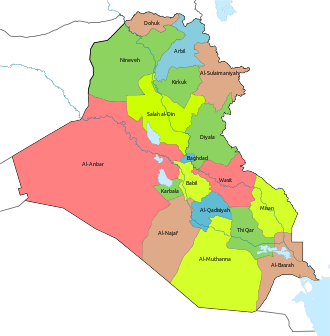Governorates of Iraq
| Iraqi Governorates المحافظات العراقية (Arabic) پارێزگاکانی عێراق (Kurdish) | |
|---|---|
|
Also known as: Muḥāfażah محافظة (Arabic) پارێزگا, Parêzgeha (Kurdish) | |
 | |
| Category | Federated state |
| Location | Republic of Iraq |
| Number | 19 governorates |
| Populations | 337,000 (Halabja) – 7,055,200 (Baghdad) |
| Areas | 734 km2 (283.4 sq mi) (Baghdad) – 138,500 km2 (53,476 sq mi) (Al Anbar) |
| Government | Governorate |
| Subdivisions | Districts |
_of_Iraq_2008.svg.png) |
| This article is part of a series on the politics and government of Iraq |
| Constitution |
|
Legislature |
|
Judiciary |
|
Iraq consists of 19 governorates (muḥāfażah in Arabic), also known as "provinces". Former President Saddam Hussein divided the country into eighteen governorates in the 1970s for reasons of ethnic manipulation.[1] A portion of the Kurdish-inhabited area of the country was granted autonomy in 1970. In 2003, after opposition from Kurdish people regarding the division of Kurdistan into governorates,[1] the autonomous standing of only three Iraqi Kurdish provinces was re-confirmed in 2005 in the constitution of Iraq,[2] leaving out many other Kurdish majority regions, such as Kirkuk, Khanaqin, Sinjar and Mandali-Badra, outside the autonomous Kurdish region. In 2014 the decision was made to create the Halabja Governorate out of the Halabja District of Sulaymaniyah Governorate.[3][4]
On 21 January 2014, the Council of Ministers of the Government of Iraq approved in principle proposals to create more governorates.[5] The Council announced that two new governorates Tal Afar and Tuz Khurmatu would be formed from the current Nineveh Governorate and Saladin Governorate, respectively.[6] It was also announced that the city of Fallujah of the Al Anbar Governorate would become a separate governorate,[5] which was announced in response to a Sunni Islamist uprising in the city.
Governorates
| Governorate | Code | Total area in miles2 |
Total area in km2 |
Population 7 January 2011 |
Capital |
|---|---|---|---|---|---|
| Al Anbar | 31 | 53,476 | 138,501 | 1,561,400 | Ramadi |
| Babil | 51 | 1,976 | 5,603 | 1,820,700 | Hillah |
| Baghdad | 10 | 283 | 734 | 7,055,200 | Baghdad |
| Basra | 61 | 7,360 | 19,070 | 2,532,000 | Basra |
| Dhi Qar | 64 | 5,000 | 12,900 | 1,836,200 | Nasiriyah |
| Al-Qādisiyyah | 58 | 3,148 | 8,153 | 1,134,300 | Al Diwaniyah |
| Diyala | 32 | 6,828 | 17,685 | 1,443,200 | Baqubah |
| Dohuk | 42 | 2,530 | 6,553 | 1,128,700 | Dohuk |
| Erbil | 44 | 5,820 | 15,074 | 1,612,700 | Erbil |
| Halabja | 46 | 1,180 | 3,060 | 337,000 | Halabja |
| Karbala | 56 | 1,944 | 5,034 | 1,066,600 | Karbala |
| Kirkuk | 36 | 3,737 | 9,679 | 1,395,600 | Kirkuk |
| Maysan | 62 | 6,205 | 16,072 | 971,400 | Amarah |
| Muthanna | 66 | 19,980 | 51,740 | 719,100 | Samawah |
| Najaf | 54 | 11,129 | 28,824 | 1,285,500 | Najaf |
| Nineveh | 41 | 14,410 | 37,323 | 3,270,400 | Mosul |
| Saladin | 34 | 9,556 | 24,751 | 1,408,200 | Tikrit |
| Sulaymaniyah | 46 | 6,573 | 17,023 | 1,878,800 | Sulaymaniyah |
| Wasit | 52 | 6,623 | 17,153 | 1,210,600 | Kut |
Previous governorates
| Governorate | Now part of |
|---|---|
| Mosul | Nineveh Governorate and Dohuk Governorate |
| Diwaniya | Al-Qādisiyyah Governorate, Muthanna Governorate and Najaf Governorate |
| Dulaim {-1962), Ramadi (1962-1976} | Al Anbar Governorate |
| Muntafiq (-1976) | Dhi Qar Governorate |
| Amara (-1976) | Maysan Governorate |
| Kut (-1976) | Wasit Governorate |
| Baghdad | Baghdad Governorate and Saladin Governorate |
| Kikuk {-1976), At-Ta'mim (1976-2006} | Kirkuk Governorate |
Formerly claimed governorates
- Kuwait Governorate (1990–91)
See also
References
- 1 2 Brendan O'Leary (11 August 2006). The Future of Kurdistan in Iraq. University of Pennsylvania Press. pp. 30–31. ISBN 0-8122-1973-2.
- ↑ Iraqi Constitution, Article 113.
- ↑ "KRG order turning Halabja into province sets off street celebrations". Rudaw. 14 March 2014. Retrieved 13 August 2016.
- ↑ "Kurdistan Region President signs Halabja province directive". Kurdistan Region Presidency. 16 March 2014. Retrieved 13 August 2016.
- 1 2 "Resolutions of Council of Ministers For Session No. 3 on 21/1/2014". 21 January 2014. Retrieved 13 August 2016.
- ↑ "Iraqi Council of Ministers approved new provinces of Tuz Khurmatu and Tal Afar". Kurd Net. 21 January 2014. Retrieved 23 August 2014.